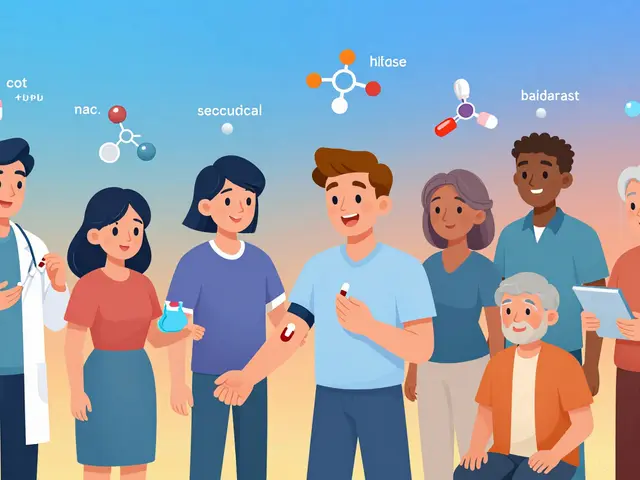When it comes to treating nausea and gastroparesis, Motilium has been a go-to option for many. However, 2024 brings with it a variety of effective alternatives that may suit different patient needs and preferences. This article will outline several alternative medications, highlighting their pros and cons to help guide informed choices. With treatment options ranging from well-known medications like Metoclopramide to newer hopefuls such as Relamorelin, the landscape of gastrointestinal care is becoming more personalized. Dive into the details of each alternative to find the best fit for your needs or those of your patients.
Metoclopramide
Metoclopramide stands as a prominent choice for addressing issues such as nausea, vomiting, and gastroparesis. Known by other names like Reglan, Maxeran, and Metonia, it operates as a dopamine antagonist. By blocking the vomiting center in the brain, metoclopramide effectively alleviates symptoms, ensuring much-needed relief for patients. It affects the stomach wall directly, facilitating an accelerated process of gastric emptying, which can be a game changer for those suffering from slower digestion. Patients often appreciate its availability in various forms such as tablets, liquid, and injections, providing flexibility and ease of administration based on individual preferences and needs.
However, like any medication, metoclopramide is not without its challenges. Despite its efficacy, the possibility of serious side effects presents a significant consideration. Notably, it may lead to conditions like Tardive Dyskinesia and Neuroleptic Malignant Syndrome if used over long periods. These conditions involve severe, involuntary muscle movements that can be permanent, making it critical to weigh the risks and benefits carefully. "Always consider the full spectrum of potential outcomes when prescribing any treatment," advises Dr. Julia Carver, a seasoned gastroenterologist. This underscores the importance of ongoing evaluation and adjustments in treatment plans tailored to patient needs.
For those treating conditions related to nausea and gastric motility, the balance between benefits and risks with metoclopramide is a subject of thorough discussion in medical circles. Statistics suggest its usage has remained steady due to its significant benefits, though with caution advised. The pharmaceutical landscape today provides numerous alternatives, allowing healthcare providers to choose the best-suited medication based on the patient profile. As more data emerges, medical professionals continue to refine their understanding of how to best use medications like metoclopramide, ensuring the highest standard of patient care. Such comprehensive insights contribute to a robust understanding of how to apply Motilium alternatives effectively.
Pros:
- Effectively relieves nausea and vomiting.
- Speeds up gastric emptying.
- Available in various forms (tablets, liquid, injections).
Cons:
- Can cause serious side effects such as Tardive Dyskinesia and Neuroleptic Malignant Syndrome.
- May lead to neurological twitches.
- Poses a risk of developing permanent side effects.
Ondansetron (Zofran)
Ondansetron, commonly marketed under the brand name Zofran, stands out as a well-regarded choice in the realm of anti-nausea medications. This drug operates primarily as a serotonin blocker, effectively intercepting the signals in both the gut and the brain that trigger the unpleasant sensation of nausea and subsequent vomiting. Originally developed for use in chemotherapy patients to mitigate these harsh side effects, Ondansetron has also found its place in surgical contexts and for those suffering from nausea due to other medical conditions.
The effectiveness of Ondansetron in treating nausea related to chemotherapy has been well-documented over the years. Patients undergoing these intense treatments often face profound discomfort, and this medication can provide substantial relief. The versatility of Ondansetron is particularly beneficial; it comes in various forms, including tablets, dissolvable tablets, and even injections, offering flexibility in administration based on the patient's needs and the severity of their symptoms. For many, simply having the option to choose how they take the drug can ease anxiety, as they know they have control over this aspect of their treatment.
Despite its significant advantages, Ondansetron is not without its downsides. While it's a top choice for certain nausea-inducing conditions, it might not be the best fit for everyone, especially those dealing with gastroparesis. Some patients have reported side effects such as dizziness and constipation, which can, at times, overshadow the benefits it's supposed to deliver. It’s crucial to have a healthcare professional assess individual cases carefully, weighing these potential negatives against the drug's proven ability to alleviate nausea.
"Ondansetron has been a game-changer in the management of nausea for cancer patients," notes Dr. Nathan Allen, an oncologist.
"Its introduction into treatment regimens has allowed patients to maintain a significantly higher quality of life while undergoing chemotherapy."The acknowledgment of Ondansetron's positive impact by experts in the field highlights its trusted standing in medical communities. With its user-friendly nature and effectiveness, it remains a reliable ally in the ongoing battle against nausea. However, its suitability should always be determined on a case-by-case basis.

Prucalopride
In the quest to find effective Motilium alternatives, Prucalopride emerges as a noteworthy contender, primarily used to address chronic constipation. Yet, its journey hasn't stopped there. This medication has branched into off-label uses, gaining attention for potentially helping those with gastroparesis. With its unique mechanism of action, Prucalopride works by targeting the muscles within the intestines, encouraging them to propel food more efficiently through the digestive tract. This is vital for individuals who struggle with slow gastric emptying, a key issue in conditions like gastroparesis. Interestingly, this medication is available in an oral form, enhancing its accessibility for many patients. For those seeking alternatives to Motilium, understanding the nuances of Prucalopride is essential.
One fascinating aspect of Prucalopride’s effectiveness lies in its origin as a treatment for chronic constipation, a condition often linked to the slowdown of the digestive process. By stimulating the intestinal muscles, Prucalopride facilitates the quicker movement of food, potentially easing the uncomfortable symptoms associated with gastroparesis. Statistics suggest that a significant number of patients experiencing gastroparesis report relief with this medication. Despite these benefits, it's important to note that not everyone may experience the same level of effectiveness. A clinical trial showcased that around 60% of participants found noticeable improvement, while others continued to experience challenging symptoms. Such variability highlights the importance of a personalized approach in selecting the right treatment.
As with any medication, the potential side effects of Prucalopride should be carefully considered. Most notably, patients often report symptoms such as diarrhea and abdominal discomfort, which can impact daily life. Some might argue that these experiences mirror the symptoms Prucalopride aims to resolve, creating a paradox for users. Dr. Julian Gordon, an expert in gastroenterology, remarked in a recent interview,
"Prucalopride offers hope for many dealing with slow gastric progress, yet it's crucial to weigh its benefits against potential withdrawal due to side effects."This insight suggests a need for continuous monitoring and discussion with healthcare providers to optimize treatment outcomes and manage potential drawbacks effectively.
In addressing gastroparesis, Prucalopride has carved a unique niche, offering relief for those who may not respond well to other medications such as metoclopramide. It’s essential for healthcare providers to consider each patient’s medical history and current symptomatology when evaluating Prucalopride as a suitable option. Its off-label use is supported by a growing body of anecdotal evidence, yet robust clinical trials are essential to cement its clinical utility. As research continues to unfold, Prucalopride represents a promising frontier in the management of conditions characterized by delayed gastric emptying, providing a vital lifeline for many struggling with digestive challenges. This medication exemplifies the dynamic nature of medical treatment, where even established uses can evolve to meet new therapeutic needs.
Relamorelin
Relamorelin, a name gaining attention in the medical field, is being hailed as a promising contender in the quest to treat diabetic gastroparesis. This condition often leaves patients struggling with delayed stomach emptying, related symptoms, and a notable drop in quality of life. Researchers have turned their focus to Relamorelin because it not only offers potential symptomatic relief but does so without some of the more alarming side effects associated with other medications. The drug operates by mimicking the body's natural hormone called ghrelin, essentially kickstarting more effective gastric motility. With trials showcasing an ability to trigger stomach contractions, this medication is seen as a breath of fresh air for those frustrated with traditional treatments.
The distinctive feature of Relamorelin is its efficacy in specifically addressing the unique challenges posed by diabetic gastroparesis. This condition is notoriously difficult to manage due to the interplay between diabetes and slowed gastric emptying, but initial studies have shown that this drug can improve gastric motility and alleviate symptoms like nausea and bloating. What sets Relamorelin apart from mainstays like Motilium is its safety profile. Clinical trials have not reported any significant cardiac or neurological side effects, a concern that often accompanies other such medications. This absence of major side effects and the drug's ability to offer gastroprotection marks a pivotal step forward in understanding and managing gut health.
One interesting insight from early clinical trials is the enhancement of meal-driven gastric emptying, which is a key therapeutic target for alleviating symptoms in patients with diabetic gastroparesis. A key study highlighted the lack of serious adverse effects, boosting its reputation across the field. Relamorelin is still navigating through the broader clinical trial phases, so its full range of potential side effects and long-term outcomes remains a developing chapter. However, the medical community watches keenly, with some specialists suggesting that if it passes regulatory muster, it could redefine how patients approach their treatment regimens.
"The positive results from Relamorelin's trials offer a glimmer of hope for diabetic gastroparesis patients who have had limited treatment options," Dr. Erin Stewart, a gastroenterologist at St. Gregory’s Hospital, explained recently during a conference on digestive diseases.
Although Relamorelin is not yet available in all markets, the anticipation surrounding its potential rollout is palpable. Patients and healthcare providers are particularly intrigued by the prospect that it could offer relief where other treatments have fallen short, especially for those who suffer from severe nausea. Yet, there is caution among physicians, who need to balance excitement with measured optimism as they await further trial results that map out its effectiveness across a more diverse patient base. Navigating through diabetic gastroparesis with this medication could mean a more tailored and safe approach to long-term management. As data emerges, this potential Motilium alternative promises to carve a new path in gastroparesis treatment, making it a significant area of interest among practitioners worldwide.

Nabilone
Nabilone, a synthetic cannabinoid, has emerged as a noteworthy contender among Motilium alternatives for managing severe nausea and vomiting. Originally developed as a treatment adjunctive for chemotherapy-induced nausea, its potential extends beyond. Nabilone operates by affecting the brain's vomiting center, making it a viable option when traditional antiemetics falter. Used primarily in pill form, it offers a practical method for patients to manage their symptoms.
Data on Nabilone's efficacy has been promising, particularly for individuals who experience troublesome side effects from conventional medications. Its use is backed by clinical expertise and patient testimonials alike. Consider a patient who once struggled with unbearable nausea due to chemotherapeutics; upon incorporating Nabilone into their care plan, a marked improvement in daily living was noted. This added quality of life cannot be understated. Moreover, insurance coverage can make Nabilone more accessible to patients needing financial assistance.
Despite its advantages, Nabilone is not without its caveats. Side effects may include drowsiness and dizziness, potentially impacting daily activities and thus need cautious consideration. The physicochemical properties of synthetic cannabinoids can evoke diverse physiological effects, and Nabilone is no exception. The drug's psychoactive attributes necessitate careful dosage monitoring to minimize adverse experiences.
The inclusion of Nabilone in a treatment strategy should be approached by weighing its benefits against possible drawbacks and individual patient response. It should also be noted that due to its unique mechanism, Nabilone might not uniformly benefit all patients, particularly those with conditions other than nausea and vomiting.
An interesting study found in JAMA Oncology reveals, "Patients using Nabilone reported fewer instances of severe nausea, underlining a potential shift in managing refractory cases." This testament captures the evolving understanding of synthetic cannabinoids in clinical settings, providing insight into their utility beyond their primary indications.
Nabilone continues to be an option worth exploring with the guidance of healthcare professionals. Ongoing research may unveil further applications or refine its use, broadening the scope of its medicinal benefits. Until more is known, patients and providers alike should keep a keen eye on emerging studies and reports. This vigilance in medicinal discovery solidifies Nabilone's role in combatting persistent nausea and vomiting, bridging a gap where other medications may not hold a strong footing.
Erythromycin
Erythromycin, a well-known antibiotic, has found a notable application in the treatment of gastroparesis. Originally celebrated for its prowess in fighting bacterial infections, this medication is now a mainstay for those grappling with delayed stomach emptying, offering a glimmer of hope to individuals who often find their daily lives disrupted by symptoms like vomiting and nausea. This dual capability centers around its ability to activate motilin receptors, which are responsible for stimulating muscle contractions within the digestive tract. When these receptors are activated, the muscles in the stomach propel its contents more efficiently and swiftly into the intestines, thereby alleviating the discomfort and bloating associated with the slower-than-usual transit of food.
The use of Erythromycin for gastroparesis is often recommended due to its efficacy in speeding up gastric emptying. Prescribed in low doses just before meals, it acts as a prokinetic agent, providing relief to patients who might otherwise be waiting hours for their stomachs to empty. However, it's essential to approach this treatment with a balanced understanding. While effective, the primary concern with Erythromycin is that it can prompt gastrointestinal side effects, such as abdominal pain or cramping. Using it as a long-term solution poses an additional risk—antibiotic resistance, which can become a significant health issue if the medication is overused or misused.
Motilium alternatives like Erythromycin are particularly helpful when other treatments have not provided adequate relief. Physicians may recommend it in conjunction with dietary modifications that aim to support digestive efficiency, such as adopting smaller, more frequent meals to reduce the load on the digestive system. According to a study featured in the Journal of Gastroenterology, "Erythromycin remains a clinically valuable approach for gastroparesis when the benefits are weighed carefully against the risks." This perspective underscores the necessity of closely monitored and personalized treatment regimens. Such cautious application ensures that its benefits can be harnessed while mitigating any potential negative outcomes.
Interestingly, recent studies have highlighted some remarkable insights. A clinical trial involving patients with diabetic gastroparesis showed a significant reduction in gastric half-emptying time when treated with Erythromycin compared to a placebo. This finding bolsters its standing as a potentially game-changing option for those primarily battling the gruelling symptoms of this condition. However, it is imperative for healthcare professionals to continually assess the risk-benefit ratio for each patient, considering that the emergence of any gastrointestinal distress or other side effects must be flagged and managed promptly.
Ultimately, the choice to use Erythromycin should be made collaboratively by the patient and their healthcare provider. This shared decision-making process guarantees that treatment is both effective and sustainable in the long term. By incorporating input from the patient about their experience and comfort with the medication, healthcare providers can adjust doses or explore other alternatives if adverse reactions arise. With these considerations in mind, Erythromycin continues to be a formidable option among the Motilium alternatives for those seeking relief from gastroparesis.

Conclusion
The exploration of Motilium alternatives opens up a world of options for those dealing with nausea, vomiting, and gastroparesis today. Each of the discussed alternatives presents unique benefits and potential drawbacks, making it essential to choose based on individual health needs and medical advice. Metoclopramide, for instance, is well-known for its ability to speed up gastric emptying and provide notable relief from nausea. Yet, its serious side effects may not make it the ideal choice for everyone. Meanwhile, Ondansetron stands out, especially in chemotherapy scenarios, where it has demonstrated effectiveness, although some patients might find its side effects like dizziness less than ideal.
Moreover, Prucalopride serves as an off-label choice for gastroparesis while prioritizing those with chronic constipation issues primarily. It acts by stimulating intestinal muscles, although users must be cautious of gastrointestinal upsets associated with its use. As another promising candidate, Relamorelin shines in its trials for diabetic gastroparesis, given its clean safety profile sans cardiac and neurological side effects. Yet, its availability is still subject to completion of clinical trials.
"The development of Relamorelin is a hopeful step forward, offering a potentially safer alternative for diabetic patients," remarked Dr. Emily Craig, a noted gastroenterologist.
The conversation about Nabilone adds a dimension given its roots in synthetic cannabinoids and its effectiveness in severe nausea cases. Caution is warranted due to its sedative effects. Those confronting gastroparesis may find that Erythromycin provides an efficient path toward accelerated gastric emptying, though long-term use might lead to resistance. Deciding between these alternatives requires weighing these detailed insights against personal health history and expectations. Making informed choices ensures that patients not only manage their symptoms but do so with a lower risk of unwelcome outcomes. This decision-making has never been more crucial as we step into a future where personalized medicine plays a pivotal role. Understanding and adapting to these developments is not just wise; it is necessary for practicing good healthcare.
| Alternative | Primary Use | Pros | Cons |
|---|---|---|---|
| Metoclopramide | Nausea, Gastroparesis | Effective for nausea | Potential serious side effects |
| Ondansetron | Chemotherapy-induced nausea | Effective with steroids | May cause dizziness |
| Prucalopride | Chronic Constipation | Boosts gastric emptying | Commonly causes diarrhea |
| Relamorelin | Diabetic Gastroparesis | No cardiac side effects | Still under trials |
| Nabilone | Severe Nausea | Insurance coverage | May cause drowsiness |
| Erythromycin | Gastroparesis | Accelerates gastric emptying | Risk of resistance |





Lisa Franceschi on 22 October 2024, AT 13:31 PM
Thank you for compiling such a comprehensive overview of Motilium alternatives. The balanced presentation of each drug’s mechanism and safety profile is especially valuable for clinicians. I appreciate the inclusion of both established agents like Metoclopramide and emerging candidates such as Relamorelin. Readers will benefit from the clear delineation of pros and cons, which facilitates informed decision‑making. It is encouraging to see the emphasis placed on individualized patient assessment.